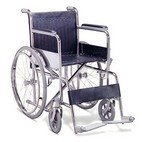*
Paraplegic Equipment
(Held Hostage By Medical Supply Extortionists)
* * *
Before the physical trauma can heal, before you can mentally come to terms with your newly acquired paraplegia, decisions may have to be made as to the medical equipment and supplies you will need for life on the outside - or so they will tell you.One of the first instructions my wife and I received was to consider which suppliers we would like to deal with. We were advised that we may wish to deal with only one to minimize confusion and perhaps negotiate a better rate. This advice was immediately overridden. As related in a previous post, I was told that I would need a custom built commode because my legs had seized up from prolonged bed rest, refusing to bend at the knees. This commode would have adjustable legs to accommodate my rigid joints. The order was placed with a vendor without consulting myself or my family.
 Although the device was required immediately, the order took about 5 to 6 weeks to be completed. A huge stainless steel unit arrived ready for my “test drive” however by the delivery date, physiotherapy had freed my joints so that the custom feature was no longer necessary and a much cheaper stock commode would have sufficed. Although the $6000 item was pretty much self explanatory in it’s use, no papers or manual came with it as to its care, maintenance, service and warranty. As a commode is not covered by either government assistance nor my private health insurance, payment for the $6000 wheeled monster was entirely my responsibility and the only way I found out who the vendor was, was through the manufacturer’s name on the invoice.
Although the device was required immediately, the order took about 5 to 6 weeks to be completed. A huge stainless steel unit arrived ready for my “test drive” however by the delivery date, physiotherapy had freed my joints so that the custom feature was no longer necessary and a much cheaper stock commode would have sufficed. Although the $6000 item was pretty much self explanatory in it’s use, no papers or manual came with it as to its care, maintenance, service and warranty. As a commode is not covered by either government assistance nor my private health insurance, payment for the $6000 wheeled monster was entirely my responsibility and the only way I found out who the vendor was, was through the manufacturer’s name on the invoice.Regardless, this custom made marvel’s leg supports proved to be too long for me even at their shortest extension. As I am just short of 6 feet tall, I have no idea who the giant was that this commode was modelled for. The back support started to unravel and fall apart just months after bringing it home. Oh, I wasn’t permitted to take it home until paid in full. Compassion and necessity be damned!
 The situation was just about identical for my wheelchair. Not knowing even what questions to ask, my fate remained in the hands of the health care “professionals”. A loaner electric wheelchair appeared in my room a couple of weeks after my arrival. I didn‘t question my mode of transportation as I was delighted to be mobile and able to receive proper physiotherapy in the gym. In the meantime my personal wheelchair was to be constructed. The problem arose when my physio & occupational therapists agreed that I would benefit from a chair that tilts back to relieve pressure. The vendor that had constructed the commode did not manufacture tilting electric wheelchairs but the bargain price of $6000 was negotiated only if they would receive the order for my electric wheelchair as well. A dilemma! How this was ultimately resolved, I do not know. I was advised not to discuss the issue if I encountered the vendors and with some negotiations behind the scenes some compromise was reached. I now had a $6000 stainless steel commode and an $18,000 electric wheelchair. The federal government did cover three quarters of the total cost leaving a $4500 hole in my bank account. My private insurance would cover a manual chair at 100% but not my portion of the electric chair.
The situation was just about identical for my wheelchair. Not knowing even what questions to ask, my fate remained in the hands of the health care “professionals”. A loaner electric wheelchair appeared in my room a couple of weeks after my arrival. I didn‘t question my mode of transportation as I was delighted to be mobile and able to receive proper physiotherapy in the gym. In the meantime my personal wheelchair was to be constructed. The problem arose when my physio & occupational therapists agreed that I would benefit from a chair that tilts back to relieve pressure. The vendor that had constructed the commode did not manufacture tilting electric wheelchairs but the bargain price of $6000 was negotiated only if they would receive the order for my electric wheelchair as well. A dilemma! How this was ultimately resolved, I do not know. I was advised not to discuss the issue if I encountered the vendors and with some negotiations behind the scenes some compromise was reached. I now had a $6000 stainless steel commode and an $18,000 electric wheelchair. The federal government did cover three quarters of the total cost leaving a $4500 hole in my bank account. My private insurance would cover a manual chair at 100% but not my portion of the electric chair.After taking possession of the electric wheelchair, I was queried by numerous patients and friends as to why I was piloting an electric wheelchair and not a manual model as my upper body strength was not affected by my illness. I had no answers as the health care “professionals” had made the choice on my behalf without discussing the rationale.
 Having become incontinent from my illness, I had been fitted with an indwelling foley urinary catheter on admission. I was left uncertain as to how I was to deal with this problem once discharged. At first it was hinted that I would have to have to change the indwelling catheter myself monthly, or have a nurse come in to do it for me. If it became infected, I might be expected to spend hours at the local emergency ward waiting to have it removed and antibiotic therapy initiated. Threading this long foreign object up my penis then inflating the retaining balloon did was not appealing in the least.
Having become incontinent from my illness, I had been fitted with an indwelling foley urinary catheter on admission. I was left uncertain as to how I was to deal with this problem once discharged. At first it was hinted that I would have to have to change the indwelling catheter myself monthly, or have a nurse come in to do it for me. If it became infected, I might be expected to spend hours at the local emergency ward waiting to have it removed and antibiotic therapy initiated. Threading this long foreign object up my penis then inflating the retaining balloon did was not appealing in the least.Near the end of my stay I was cheerfully told that I would be going on I.C.s. Nobody had explained to me what I.C.s were. No they weren’t “Integrated Circuits” but rather referred to “Intermittent Catheterization”.
 Yes, that’s right. Once again you get to have the pleasure of sticking a piece of plastic up your “willy” but now it is about every 6 hours instead of monthly. Equally unappealing plus impractical. My severe spasms would trigger whenever in the vicinity of my groin plus you must have a wheelchair accessible washroom within reach at all times. Or in the very least, a quiet corner and a receptacle.
Yes, that’s right. Once again you get to have the pleasure of sticking a piece of plastic up your “willy” but now it is about every 6 hours instead of monthly. Equally unappealing plus impractical. My severe spasms would trigger whenever in the vicinity of my groin plus you must have a wheelchair accessible washroom within reach at all times. Or in the very least, a quiet corner and a receptacle. It was only by chance that I was in a rush one morning that the staff offered me a condom catheter. As the name implies, this one is worn on the outside and urine collects in a bag strapped to the leg. Not a pleasant solution but for me, much more acceptable than the other two. It worked…
It was only by chance that I was in a rush one morning that the staff offered me a condom catheter. As the name implies, this one is worn on the outside and urine collects in a bag strapped to the leg. Not a pleasant solution but for me, much more acceptable than the other two. It worked…There are a variety of medical supply options, which should be discussed or offered to the patient unless their medical condition absolutely demands the use of one specific device .I suspect that some staff members have their own personal preferences and chose these to simplify their own work day. . If the medical supply business is like any other, I suspect there are some, aaahhh, hmmm, shall we say “kickbacks” to the facility if certain brands and products are pushed

 Having arrived home, I required a “Hoyer Bariatric Lift “and sling to transfer me from the bed to the chair and back. Some may need this option permanently and the choice must be maid as to have a movable unit on wheels or an overhead unit running on tracks. Both are unsightly contraptions and ridiculously expensive. As I have my upper body strength, I tried to learn to “transfer” in order to rid my self of these aids.
Having arrived home, I required a “Hoyer Bariatric Lift “and sling to transfer me from the bed to the chair and back. Some may need this option permanently and the choice must be maid as to have a movable unit on wheels or an overhead unit running on tracks. Both are unsightly contraptions and ridiculously expensive. As I have my upper body strength, I tried to learn to “transfer” in order to rid my self of these aids.It always seemed to me that the art of transferring was most suited to those individuals who’s relatives had crawled out of the evolutionary tree much later than myself. I have never been able to scratch my knees without bending over so my arms are relatively short. Because of this physical attribute, I cannot get myself airborne with ought the use of pommels. These are simple devices which when gripped and pushed upon, raises your butt off of the sitting surface by a sufficient amount as to allow lateral movement. Suppliers of this item were difficult to find and once located I was appalled to find out that they are priced from between $150 to $250 CND per pair. Outrageous!!
I have seen both metal and wood variations of this aid. Now I have a fully equipped wood working shop in my basement but my injury has made it inaccessible to me. I decided that with some copper plumbing supplies, I could make my own at a fraction of the price.
 I purchased about 6 feet of ¾” copper plumbing pipe, 4 - ¾” 45 degree angle connectors and 4 - ¾” ‘T’ connectors. 8 - 13/16” rubber slip on feet or end caps would complete the project. Tools required were a pipe cutter, emory cloth for cleaning joints prior to soldering, solder paste to assist solder flow, a pair of vice grips or clamp to hold heated piping, a propane blow torch and the solder itself. For a hand grip. I painted the exposed copper pipe and used spongy pipe insulation as the hand grip. Custom made to my own specifications at about $35 and assembled from my wheelchair in the safety of my drive-in shower stall.
I purchased about 6 feet of ¾” copper plumbing pipe, 4 - ¾” 45 degree angle connectors and 4 - ¾” ‘T’ connectors. 8 - 13/16” rubber slip on feet or end caps would complete the project. Tools required were a pipe cutter, emory cloth for cleaning joints prior to soldering, solder paste to assist solder flow, a pair of vice grips or clamp to hold heated piping, a propane blow torch and the solder itself. For a hand grip. I painted the exposed copper pipe and used spongy pipe insulation as the hand grip. Custom made to my own specifications at about $35 and assembled from my wheelchair in the safety of my drive-in shower stall.I was equally shocked to discover that a transfer boards also cost between $150 for a wooden model to $250 CND for a high density plastic version. ($75 for a used wooden one) Once again, my woodworking shop was inaccessible for this simple project so I turned to a woodworker friend of mine who made me a couple from 5/8” Baltic birch plywood with a matte varathane finish. (gloss sticks more than matte). $20 would have covered the cost but for my friend’s generosity, I got them for free. Works well!
There is absolutely no doubt that many, if not all medical devices and products are drastically marked up in order to gouge the client/patient. They know quite well that they have the needful individual over a barrel. Besides, some of the cost will in all likelihood be covered by the government or insurance companies. No harm done, right?
It has been an eye opening experience. If I ever manage to get back to my shop, I know that I could make an honest wage selling these items to institutions or to individuals through e-bay at a modest profit.
* * *







.jpg)

2 comments:
You’ve assisted my understanding on what is usually a hard to tackle subject. Thank you!
transform@colonialmed.com
It is encouraging to hear someone express outrage at the time and expense of purchasing necessary equipment for the paraplegic. My daughter was injured thirty plus years ago and we are still fighting to obtain a decent product at a practical cost. Recent example is a new manual wheelchair to replace a over-worn chair that had been repaired multiple times until it reached the point of not being fixable again. Her justifiable new chair took over a year to obtain requiring first her insurance and medicare to approve, three separate appointments at the wheelchair clinic to ensure fit was appropriate and us saving monies to cover the medically necessary add-ons that the insurance refused to pay. To hear of someone willing to make certain items at a reasonable cost is a breath of fresh air. Medical supply businesses need the competition as they have the monopoly on access to a lot of this equipment. THEY decide whether you need it or not. We are currently looking for a patient lift as when she falls we are at the age we can no longer lift her back into her chair. So far the lifts available are so expensive; yet it is either our backs or buy one.
Post a Comment